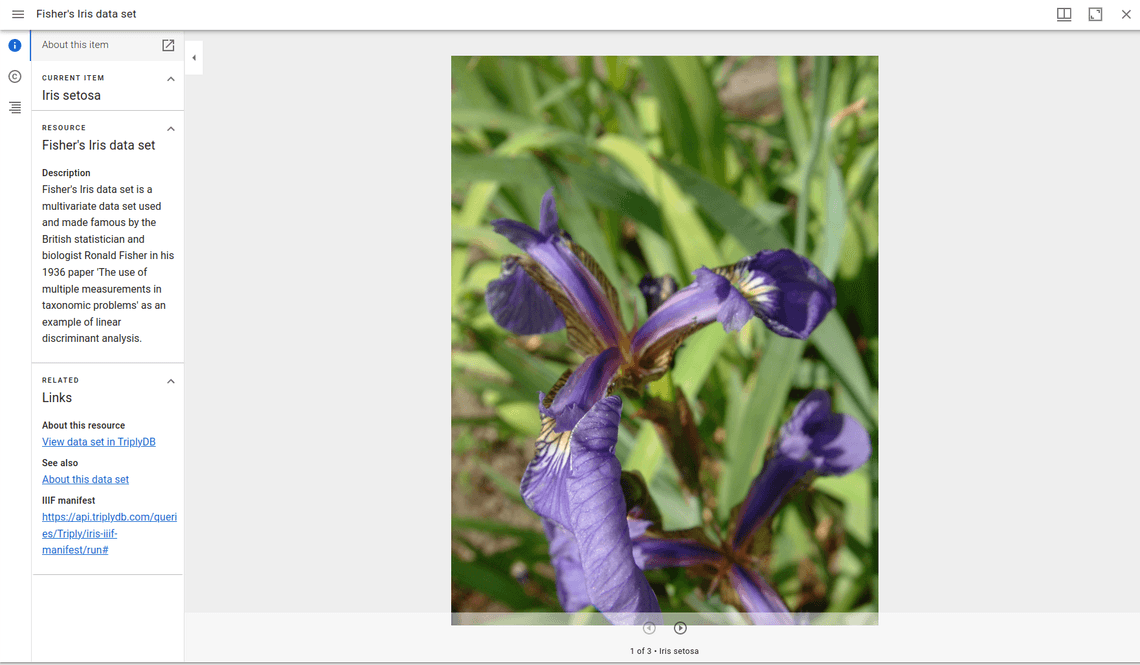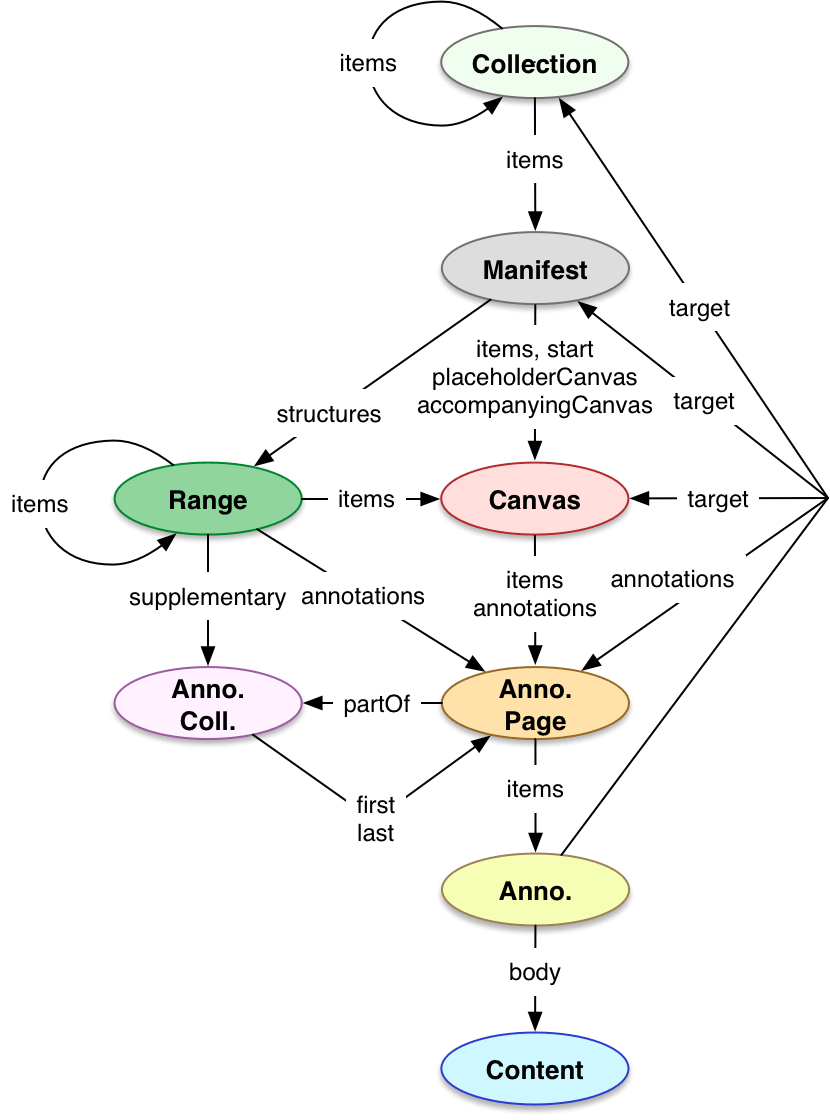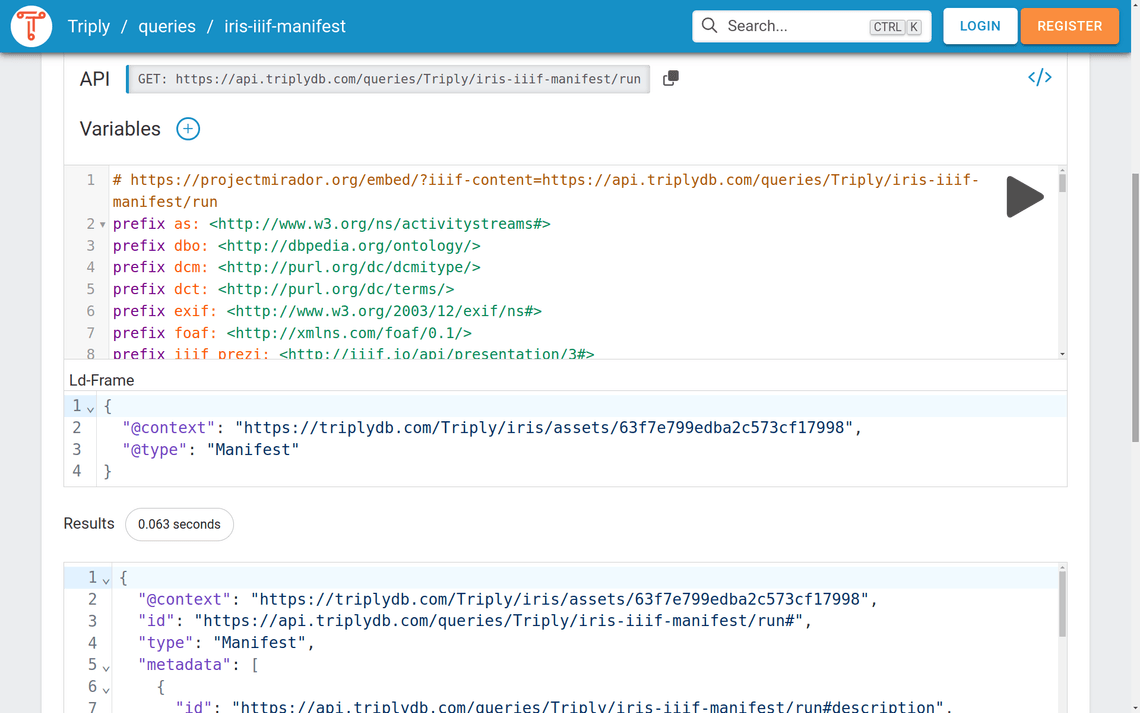IIIF support in TriplyDB
International Image Interoperability Framework (IIIF) is a universal standard for publishing images and their metadata in an open and standardized way. A growing number of organizations are using TriplyDB to implement their production-grade IIIF API. This blog post explains in-depth what IIIF is, why your organization should support it, and how you can configure it using TriplyDB.
The end result looks as follows:
- Your images can be viewed in any standards-conforming IIIF viewer.
- Up-to-date metadata is automatically retrieved from TriplyDB and is shown in the viewer.

What is IIIF?
The International Image Interoperability Framework (IIIF) is a universal standard for publishing images and their metadata in an open and standardized way. A big benefit of adopting the IIIF standard is that your images and their metadata can now be viewed in a wide number of image viewers. This is less costly and more sustainable than developing your own solution, or relying on a closed commercial format. Because of this, IIIF is widely used in the cultural heritage and academic research domains.
The two main components of a IIIF deployment are the Image API, for serving the images, and the Presentation API for serving the metadata. This blog post uses TriplyDB Assets for storing the images, and details how the Presentation API can be configured. Take a look at the official IIIF website for more information about the IIIF standards.
How can I implement the IIIF Presentation API?
There are several software implementations of the IIIF Presentation API available today. However, these implementations are somewhat complex to configure, do not always support the latest version of the IIIF standard (version 3), are not actively maintained, and/or do not meet the code quality criteria for use in a production system.
For these reasons, TriplyDB users have explored a new approach for setting up a IIIF Presentation API: one that relies exclusively on TriplyDB, and that only uses open standards. This new approach is explained in this blog post. It relies on the following open standards and requires no custom code:
- SPARQL Construct
- JSON-LD Frames
What is the IIIF Presentation API?
The IIIF Presentation API exposes metadata about a collection of objects (the "Collection" in Figure 2). In our example this is a collection of flowers. Within this collection, individual objects are described in a manifest (the "Manifest" in Figure 2). This description includes metadata, such as attribution information. One object may be depicted by multiple images and in different ways. These different views are represented in one or more canvases (the "Canvas" in Figure 2). The canvas contains metadata about one specific view, e.g. height and width, format, and the actual image content (the "Content" in Figure 2).

Notice that the data model of the IIIF Presentation API is somewhat complex (Figure 2). However, many parts of the standard are optional, and are specifically there to support inherently complex situations that do not always arise. For example, an object can be divided into multiple parts, each with its own views ("Range" in Figure 2). In this blog post we only cover the required parts.
Configuring a IIIF Manifest
The core description of a IIIF object is the Manifest. We construct the Manifest with SPARQL, and structure is with JSON-LD Frames. For demonstration purposes, we use the open Iris dataset. Notice that the same approach applies to any linked dataset, including non-open ones.
Configuration Step 1 out of 2: SPARQL Construct
The SPARQL Construct query is the largest configuration component. You can see the full query over here. We will go through this query piece-by-piece, and explain how it works.
At the beginning of the query, we declare the namespaces that are used in the rest of the query. IIIF relies on numerous community standards, including Dublin Core and Web Annotation Ontology. The declaration for "mf" refers to our own IIIF Presentation API. This allows us to refer to the API itself (self-description).
prefix as: <http://www.w3.org/ns/activitystreams#>
prefix dbo: <http://dbpedia.org/ontology/>
prefix dcm: <http://purl.org/dc/dcmitype/>
prefix dct: <http://purl.org/dc/terms/>
prefix exif: <http://www.w3.org/2003/12/exif/ns#>
prefix foaf: <http://xmlns.com/foaf/0.1/>
prefix iiif_prezi: <http://iiif.io/api/presentation/3#>
prefix mf: <https://api.triplydb.com/queries/Triply/iris-iiif-manifest/run#>
prefix oa: <http://www.w3.org/ns/oa#>
prefix rdf: <http://www.w3.org/1999/02/22-rdf-syntax-ns#>
prefix rdfs: <http://www.w3.org/2000/01/rdf-schema#>
prefix sdo: <https://schema.org/>The 'construct'-clause declares the structures that are mandated by the IIIF Presentation API. We first construct the Manifest itself. This includes a label (rdfs:label), thumbnail (iiif_prezi:thumbnail), and other metadata. Some metadata items require additional specifications; you can see these in the online version of the query. How much metadata you include here depends on your use case; linked data allows you to freely change or extend the metadata that you expose.
construct {
mf: a iiif_prezi:Manifest;
rdfs:label "Fisher's Iris data set"@en;
iiif_prezi:thumbnail <https://triplydb.com/imgs/avatars/d/6006f097506cf2034cfe4c46.png?v=25>;
iiif_prezi:requiredStatement mf:requiredStatement;
iiif_prezi:metadataEntries mf:description;
foaf:homepage <https://triplydb.com/Triply/iris/>;
rdfs:seeAlso <https://en.wikipedia.org/wiki/Iris_flower_data_set>;
sdo:provider <https://triply.cc/about/>;
as:items ?canvas.
mf:description
rdfs:label "Description"@en;
rdf:value "Fisher's Iris data set is a multivariate data set used and made famous by the British statistician and biologist Ronald Fisher in his 1936 paper 'The use of multiple measurements in taxonomic problems' as an example of linear discriminant analysis."@en.
mf:requiredStatement
rdfs:label "Attribution"@en;
rdf:value "Iris flower dataset in linked data provided by <a href=https://triply.cc>Triply</a>"@en.The manifest links (with as:items) to the next structure that must be constructed in the SPARQL query: the canvas. Notice that the canvas specifies the dimensions (exif:height and exif:width) of the image.
?canvas a iiif_prezi:Canvas;
rdfs:label ?title;
exif:height 1000;
exif:width 1000;
as:items ?page.
?page a as:OrderedCollectionPage;
as:items ?image.
?image a oa:Annotation;
iiif_prezi:motivation "painting";
oa:hasBody ?body;
iiif_prezi:target ?target.
?body a dcm:StillImage;
dct:format "image/jpeg".
}After the 'construct'-clause we write the 'where'-clause. This clause retrieves information from TriplyDB that will be used to instantiate the structure in the 'construct'-clause. In our case we want to expose every flower in our dataset (dbo:FloweringPlan). We also construct identifiers for each of the representational structures in the manifest (e.g. ?canvas).
where {
?iris a dbo:FloweringPlant;
rdfs:label ?title;
foaf:depiction ?imageString;
rdfs:comment ?description.
bind(iri(concat(str(?iris), "#sequence")) as ?sequence)
bind(iri(concat(str(?iris), "#canvas")) as ?canvas)
bind(concat(str(?iris), "#canvas") as ?target)
bind(iri(concat(str(?iris), "#page")) as ?page)
bind(iri(concat(str(?iris), "#image")) as ?image)
bind(iri(?imageString) as ?body)
}Configuration Step 2 out of 2: JSON-LD Frame configuration
When you visit the SPARQL Construct query online, you see the SPARQL Query Editor, the JSON-LD Frame Editor, and the REST API result all on one page (Figure 3). These tools allow us to configure REST APIs, including the IIIF Presentation API.

JSON-LD Frames is an international standard that allows us to create JSON structures from linked data. Which structure we create, and how we create it from our linked dataset, is configured in a frame. For our current example, the frame looks as follows:
{
"@context": "https://triplydb.com/Triply/iris/assets/63f7e799edba2c573cf17998",
"@type": "Manifest"
}The value for @context refers to a small JSON-LD file that Triply created for version 3 of the IIIF Presentation API. The official IIIF website publishes a similar file for version 2, but not (yet) for the latest version.
The value for @type indicates which item should be at the root of the JSON object that is exposed through our API. In linked data, information is not stored in a specific order. There is no 'first' or 'root' item. But the IIIF standards mandate that we return the manifest in a JSON format; and there the order of the items is crucial. Luckily, JSON-LD Frames allows us to force a specific order, thereby translating the outcomes of SPARQL Construct queries into REST API responses.
For more information, see the TriplyDB documentation about JSON-LD Frames support: link.
Conclusion
Users of TriplyDB are able to configure their own IIIF Presentation API. They do so without using custom/external software, but instead fully reply on the standardized features of TriplyDB. The configuration is entirely performed in two open standards: SPARQL Construct and JSON-LD Frames.
Every standards-compliant IIIF viewer can now access our endpoint and display our images and metadata. You can try this out by going to Mirador to see the result.
